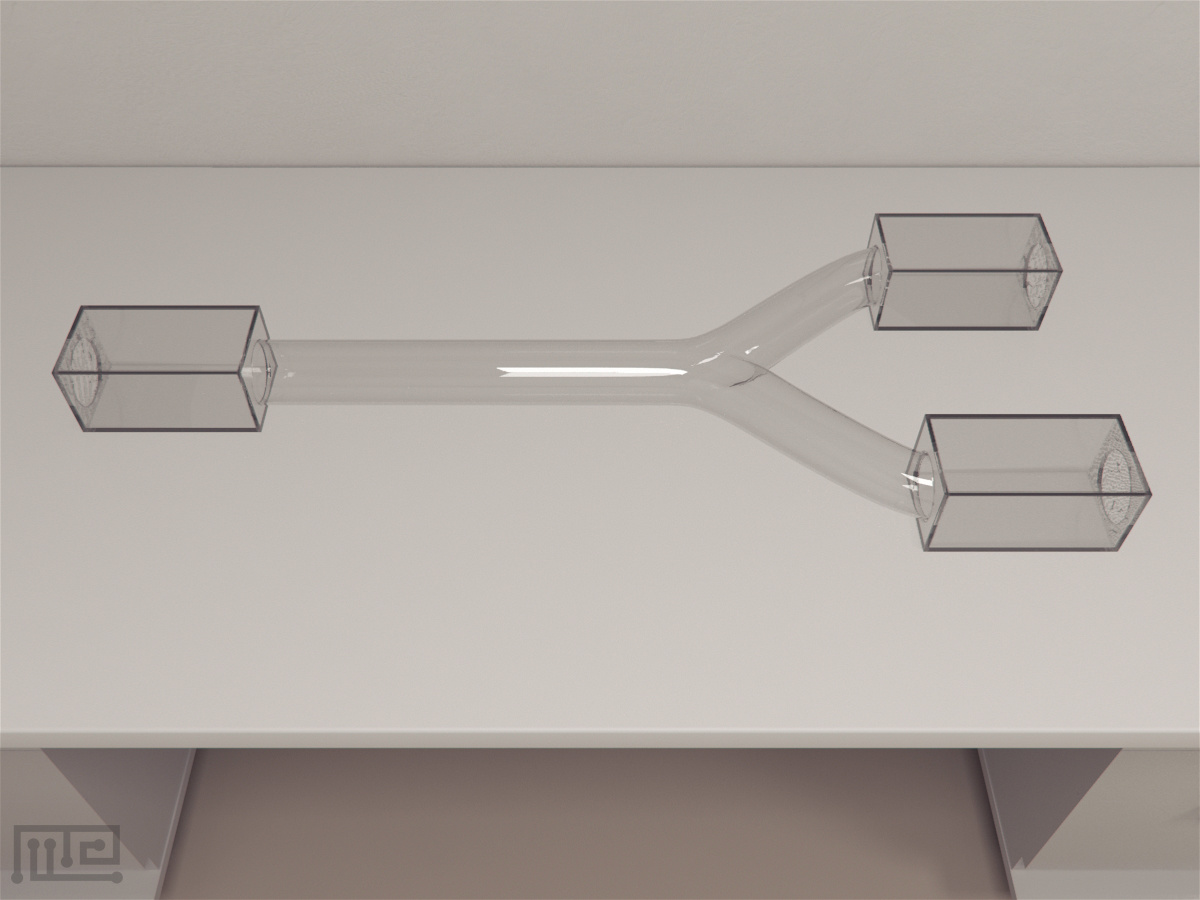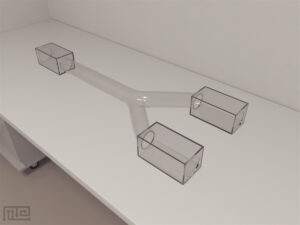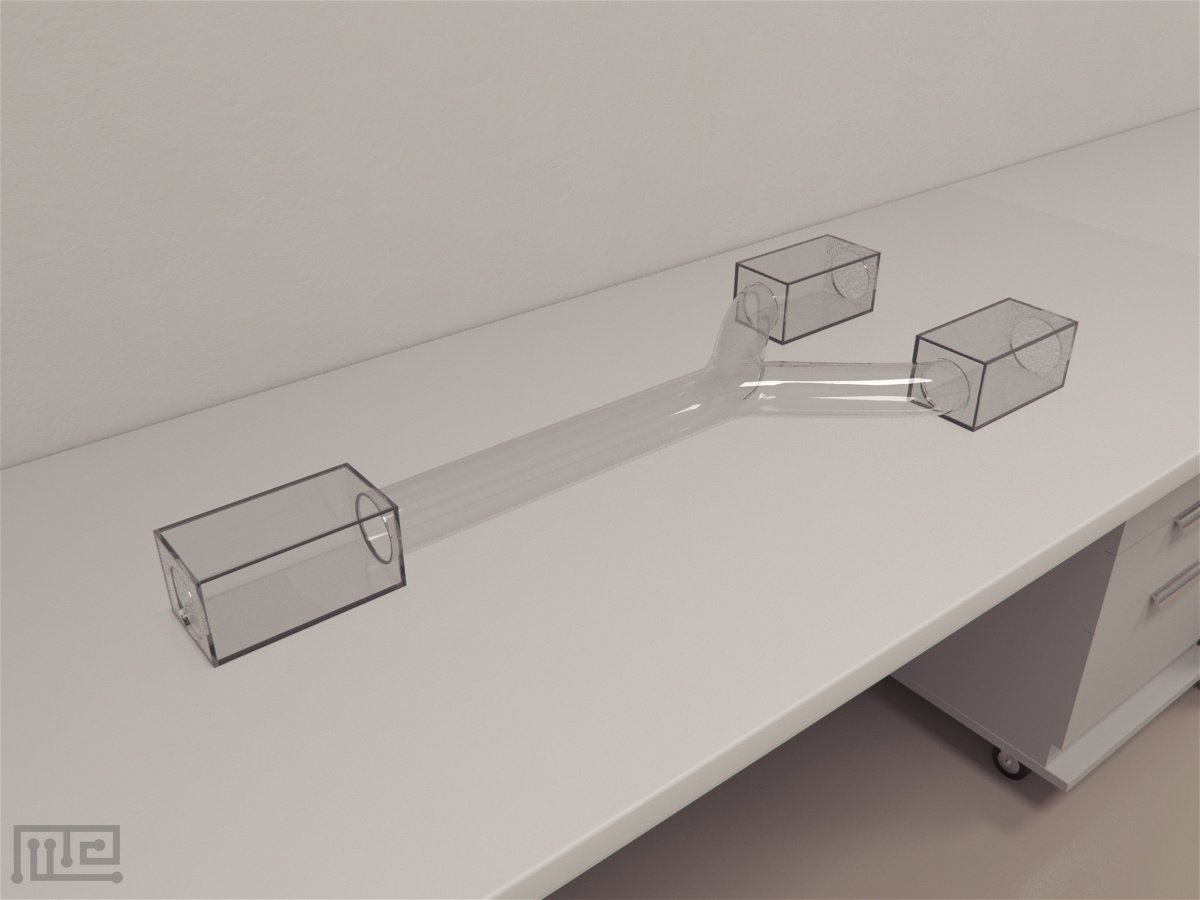The Snake Y-Maze is used to evaluate odor-based behaviors in snakes. It is an adaptation of the rodent Y-Maze used to perform learning, memory and social preference tasks in rodents.
The maze is a capital “Y” shaped apparatus with 3 opaque arms. The base arm contains the start chamber. The base arm includes a central crawlway trough leading to the Y-junction and subsequently, to the goal arms of the maze. The goal arms contain ante-chambers leading to goal rooms. The base arm of the maze can be equipped with a fan to control air flow.
Mazeengineers offers the Snake Y-Maze.
Price & Dimensions
Snake Y-Maze
$ 1190
+S&H- Length of base arms: 50cm
- Length of goal arms: 20cm
Documentation
Introduction
The Snake Y-Maze is used to evaluate odor-based behaviors in snakes. It is an adaptation of the rodent Y-Maze used to perform learning, memory and social preference tasks in rodents. The Snake Y-Maze exploits the snake’s chemosensory abilities by subjecting them to different odor stimuli. These abilities are essential for the survival, identification of potential risks, anti-predatory contexts, detection of conspecifics and social interactions.
Snakes with deficits in the vomeronasal system tend to show poorer performances in the Y-Maze than intact snakes. In addition to evaluating vomeronasal and olfactory system impairments, the Y-Maze can also be used to evaluate odor-based preferences, learning, and memory. Thus, the Snake Y-Maze serves as a powerful tool to differentiate between normal and diseased animal models. The Snake Y-Maze can also be used to assess scent or chemo- signal trailing, sex-specific behaviors, social behavior, foraging and mating behaviors.
The Snake Y-Maze is a simple apparatus consisting of a long base arm that bifurcates into shorter goal arms separated at 120 degrees from each other. The long arm contains the starting chamber which accommodates the subject and introduces it to the maze arena while antechambers at the ends of the goal arms lead to the goal rooms. The simple design of Snake Y-Maze allows the subject to use chemosensory cues to identify, locate and choose between the prey items. Automated guillotine doors can be placed at the entrance of each arm to control the subject’s movement and to restrict it from entering into one of the goal arms. Other variants of Y-Maze used for different species and investigations include Social Y-Maze, Drosophila Y-Maze, Zebrafish Y-Maze, Bat Y-Maze, and Ant Y-Maze.
Apparatus and Equipment
The Snake Y-Maze is a capital “Y” shaped apparatus with 3 opaque arms. The base arm is 50 cm in length and contains the start chamber. The base arm includes a central crawlway trough leading to the Y-junction and subsequently, to the goal arms of the maze. The central trough facilitates the straight crawling of the subject. The goal arms are 20 cm in length and contain ante-chambers leading to goal rooms. The base arm of the maze can be equipped with a fan to control air flow.
Training Protocol
Thoroughly clean the maze arena with acetone to remove any lingering odors. Maintain proper hygienic conditions by removing any traces of food, feces or urine from the maze. An external video tracking system such as Noldus Ethovision XT can also be used with Snake Y-Maze for observing the subject’s behavior.
Habituation and pre-training
Prior to testing, familiarize the subjects to different food items by feeding them at weekly intervals for 12 months. For the Odor preference task, the food scavenging behavior is favored by not feeding subjects for a period of 1 month prior to testing. Prior to the experiment, acclimatize the subjects to the maze by placing them in a start chamber of the base arm of the maze. Allow the subjects to explore the maze arena and observe their crawling tendency on the central trough.
Odor Preference task
Place the subject into the start chamber and allow it to explore the maze arena with goal arms baited with the odor stimuli. Remove the subject from maze arena once it has made its choice based and entered the goal room. Terminate the task if the subject exhibits any irritable behavior in the starting chamber or central crawlway trough and use new subjects. Replicate the testing procedure for other subjects.
Evaluation of feeding preferences and responses to prey in snakes
The purpose of the study conducted by Lillywhite, Pfaller, and Sheehy III (2015) was to identify the foraging behavior, prey preference and difference in prey acceptance between Naïve insular and mainland cottonmouth snake species. The subjects were classified into three major experimental groups: cohorts of neonatal siblings of both mainland and insular females (feeding trials were performed for 11 months, and were fed with fish, lizard, and mice); cohorts of neonatal cottonmouths of insular females (half of the cohort were fed with Sardinella aurita fish and remaining with newborn mice at weekly intervals for 12 months); and wild-caught insular neonatal cottonmouths (served with dead rat). Following the prey odor familiarization, each subject was evaluated using Snake Y-Maze. The prey acceptance of both insular and mainland neonates in the first group to prey was almost similar. None of the neonates of the second experimental group accepted food immediately after their birth. The insular neonates fed on fish selected the branch of Snake Y-Maze containing the fish and similar trend in prey preference was prevalent in neonates served with mice. The naïve neonates served and conditioned with single specific prey after their birth for 1 year followed the odors that were associated with the specific prey item in their later stages of life. These species also tended to choose an opportunistic approach and ate both mice and fish respectively, despite being conditioned to the specific food item. It was concluded that the cottonmouth neonates adjust their foraging behavior and show suppleness in their feeding behavior which allows them to occupy a wide tropic niche.
Evaluation of scent trailing and sex-specific behavior in python species
Richard, Tillman, Humphery, Avery, and Parker (2018) assessed the scent trailing behaviors shown by pythons to communicate with their potential mates. The chemical signals used in mate searching are considered as valuable tools for management of invasive animals which negatively impacts the ecological system. A total of 7 Burmese pythons (Python bivittatus) categorized into sex-specific groups were analyzed in Snake Y-Maze apparatus. The male pythons showed significant scent trailing preference for female scent and exhibited remarkable changes in head up postures and pauses. The male pythons also showed high chemosensory signaling (rate of tongue flicking) in the presence of female scent. However, in the presence of both male and female scents, the male pythons did not show any preference for female scent, and the rate of tongue flicking also decreased compared to female-only trials. It was concluded that the chemo-sensation behavior of male pythons was more frequent in female-only trials.
Data Analysis
The following parameters can be analyzed by Snake Y-Maze,
- Number of correct arm entries
- Number of wrong arm entries
- Time taken by the subject to reach respective arm of the Snake Y-Maze
- Number of tongue flicks per minute
- Rate of crawling
- Number of times subject refused to enter the crawling way
- Proportion of prey eaten by subject trained to a specific prey item
- Proportion of non-conditioned prey eaten by the subject when given the opportunity
- Number of times subjects showed directional bias
- Frequency of correct prey encounters
- Frequency of avoiding prey
Strengths and Limitations
Strengths
The Snake Y-Maze is a simple, yet powerful apparatus to observe odor-based choice and foraging behaviors in snakes. It provides easily reproducible results, requires nominal time and training of subjects during memory and cognitive ability testing tasks. The inclusion of guillotine doors makes the maze highly flexible, and this modifiability supports various protocols such as pheromone trailing behavior testing and navigational activities in snakes. The removable chambers at the ends of goal arms and base arm allow adaptation of the maze for other investigations such as olfactory conditioning protocols in pythons.
Limitations
Factors such as olfactory, auditory, visual cues, temperature, ventilation, age, weight, and the speed of the subject can affect maze performance. Inaccurate handling, training and habituation process can trigger stress in the subject; decrease its motivation to explore the maze arena and gives false positive results.
Summary
- The Snake Y-Maze is used in the evaluation of odor-based behaviors in snakes.
- The Snake Y-Maze is analogous to Y-Maze used for rodents, consisting of 3 opaque arms present at a natural angle of 120 degrees.
- The goal arms of the Snake Y-Maze contain chambers that can be baited with stimuli.
- The Snake Y-Maze can also be used in scent trailing, cognitive tasks, spatial learning, and memory testing.
- Modifications such as automatic guillotine doors allow controlling the movement of subjects in the maze arena.
References.
- Lillywhite, H., Pfaller, J., & Sheehy III, C. (2015). Feeding preferences and responses to prey in insular neonatal Florida cottonmouth snakes. Journal of Zoology, 297(2), 156-163.
- Richard, S. A., Tillman, E. A., Humphrey, J. S., Avery, M. L., & Parker, M. R. (2018). Male Burmese pythons follow female scent trails and show sex‐specific behaviors. Integrative Zoology.
Request a quote
"*" indicates required fields



